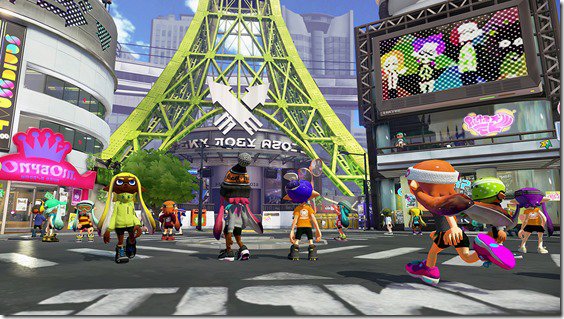I loved this year’s surprise hit Splatoon. Everyone who knows me knows this, but I wanted to discuss the game one last time this year. With the end of 2015 quickly approaching, there is no doubt that Game of the Year lists will crop up everywhere. While I love these dearly, I don’t think I really played enough games to have a good grasp on a contender. Yet one thing I think we gloss over is the importance individual games have on gaming culture. So I’d like to talk about why I consider Splatoon to be an important addition to the current gaming sphere—it shows an excellent model for future games, whether or not it was necessarily the best.
To preface everything, I want to point to sales figures for the game. As of September 2015, Splatoon has sold 2.42 million units in just four months after its release. For reference, compare that to Mario Kart 8, which was at 5.87 million from May 29, 2014 for the same game system. In a sense, this validate much of what I’m about to say; the sales indicate that this game is marketable despite some trends in the market.
Splatoon won “Shooter of the Year” at The Game Awards (as well as best multiplayer) a couple weeks back, which is interesting for a few reasons. First of all, the choice is somewhat surprising as Nintendo isn’t exactly known as a producer of shooting games to begin with. Beyond that, one could argue that this is the least violent shooter to ever be released. While there are guns and players attack each other, it’s with ink and characters never explicitly “die” from it–I mean, they call it “splatting” but, even then, it doesn’t feel like death is invoked. The violence feels different than it does with bullets, blades, and blood: it’s less realistic for sure, but it doesn’t ever feel gruesome or gory; rather, it’s kind of silly. At least personally, I don’t get the same feeling I do in, say, Call of Duty or Mortal Kombat games. The goal is never to splat/kill your opponents; it helps, but it’s never the goal. Plus, the game is vastly aesthetically different than most multiplayer shooting games, focusing more on fun and color rather than realism and grittiness.
In a similar way, Splatoon shows great potential for inclusion. I’ve mentioned this in a post before, but I don’t think repeating it hurts. So-called “hardcore” or self-proclaimed “actual gamers”, people who claim to love playing games based on their merit, will play a game if it is good. The current climate often cops out of adding diverse cast members to games because it would put off this “core” straight, white, male demographic and ultimately lose the company money. Many detractors and the like say that adding diversity or “pandering” to any other audience will ruin the game for them, but that simply isn’t the case. It doesn’t matter if a rainbow of skin colors is available, or multiple genders are offered: if a game is good, all groups of gamers will happily buy it, play it, and subsequently sink hours into it. And Splatoon’s sales numbers prove this. This may be due to how “natural” these demographics fit into its world, but it never feels like tokenism. (Also, if conservative gaming groups don’t know, progressive gaming groups aren’t exactly fans of tokenism either.) I must say that it is extremely refreshing to see so many girl squids and all the various skin colors represented by the players. Frequently, too!
Finally, the game showed that the term “games as service” (meaning that your money funds an ongoing experience, rather than a contained, “complete” package) doesn’t have to be cynical company-speak. Most games that push the promise of service are trying to squeeze money from consumers. This usually manifests in subscription fees, or season passes (paying up front to receive all upcoming downloadable content in a given span of time), which can be a gamble. Splatoon, on the other hand, offers all of its content free and fairly frequently. Since the game’s release, several stages, weapons, clothing options, and even gameplay modes have been added. In addition, there are recurring in-game events that create at least a quick reason to pop in every few weeks. While this method is most certainly not as profitable, it garners an enormous amount of goodwill from fans and future fans, proving that respecting consumers isn’t a death sentence to a publisher.
When it comes down to it, Splatoon shows what a lot of games could be. While it certainly has its flaws and room for improvement as a game, its place as a product is top notch. Nintendo has shown that inclusion and respect for consumers are absolutely something fans enjoy and are willing to support. Games like Life is Strange and Undertale similarly show examples of breaking the mold (in terms of queer relationships and pacifism, respectively, and a focus on story in both) and have been huge favorites in both fan and critical circles. Splatoon’s importance, like theirs, isn’t just a flash in the pan; striving to be better for consumers is rewarded. I think that more games can, and should, be heading in this direction. Again, it benefits fans and companies, and if everyone wins, everyone is happy.
Follow Lady Geek Girl and Friends on Twitter, Tumblr, and Facebook!





Pingback: Trailer Tuesdays: Splatoon 2 | Lady Geek Girl and Friends